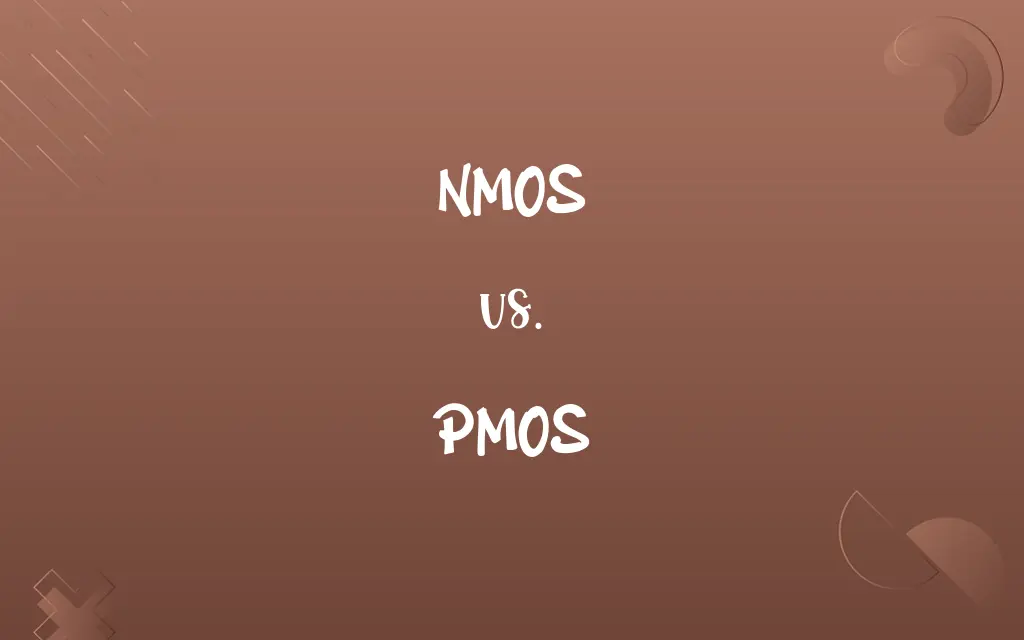NMOS vs. PMOS: Know the Difference

By Hifza Nasir & Dua Fatima || Published on March 12, 2024
NMOS transistors use n-type material for charge carriers, offering faster speeds, while PMOS employs p-type, known for lower power consumption.

Key Differences
NMOS (N-type Metal Oxide Semiconductor) transistors use electrons as charge carriers, which move faster than holes, the charge carriers used in PMOS (P-type Metal Oxide Semiconductor) transistors. This makes NMOS transistors inherently faster, suitable for high-speed applications. On the other hand, PMOS transistors, utilizing holes for charge transport, generally exhibit lower power consumption, making them preferable in power-sensitive applications.
Hifza Nasir
Mar 12, 2024
The fabrication process of NMOS transistors is simpler and less costly compared to PMOS, primarily due to the natural abundance of electrons as charge carriers. This simplicity also translates to a higher electron mobility in NMOS, enhancing its performance in terms of speed. Conversely, PMOS transistors require more complex p-type doping, which can increase production costs but offers advantages in minimizing power leakage, a critical factor in low-power devices.
Dua Fatima
Mar 12, 2024
NMOS can be packed more densely on a chip than PMOS, allowing for more transistors in a given area. This density benefits performance and cost but can lead to higher power consumption and heat generation. PMOS, while not as densely packed, benefits from lower leakage currents, reducing overall power consumption and heat, which is crucial in compact and battery-operated devices.
Dua Fatima
Mar 12, 2024
NMOS transistors exhibit higher noise margins, making them more robust in noisy environments. However, they also tend to have higher off-state leakage currents than PMOS transistors, which can be a drawback in low-power or standby applications where energy efficiency is critical.
Shumaila Saeed
Mar 12, 2024
Both NMOS and PMOS technologies are often used together in CMOS (Complementary Metal Oxide Semiconductor) technology to leverage the strengths of both: the speed and density of NMOS with the low power consumption of PMOS. CMOS is the cornerstone of modern digital electronics, offering an optimal balance between performance, power, and cost.
Hifza Nasir
Mar 12, 2024
ADVERTISEMENT
Comparison Chart
ADVERTISEMENT
NMOS and PMOS Definitions
NMOS
Utilizes electrons as charge carriers.
NMOS transistors are used in CPUs for their speed.
Hifza Nasir
Feb 26, 2024
ADVERTISEMENT
PMOS
Characterized by lower power consumption.
PMOS is preferred in power-sensitive applications.
Dua Fatima
Feb 26, 2024
NMOS
Benefits from simpler, cheaper fabrication.
NMOS circuits are cost-effective for mass production.
Dua Fatima
Feb 26, 2024
PMOS
Employs holes as charge carriers.
PMOS transistors are integral to battery-operated devices.
Hifza Nasir
Feb 26, 2024
NMOS
Exhibits higher electron mobility.
NMOS devices offer superior performance in digital electronics.
Hifza Nasir
Feb 26, 2024
PMOS
Offers lower leakage currents.
PMOS technology reduces power loss in standby mode.
Dua Fatima
Feb 26, 2024
NMOS
Prone to higher leakage currents.
NMOS standby power is higher due to off-state leakage.
Hifza Nasir
Feb 26, 2024
PMOS
Involves more complex fabrication.
The making of PMOS chips requires additional p-type doping.
Hifza Nasir
Feb 26, 2024
NMOS
Known for higher speed and power consumption.
An NMOS logic gate switches faster than PMOS.
Dua Fatima
Feb 26, 2024
PMOS
Has lower electron mobility.
PMOS transistors switch slower, affecting circuit speed.
Shumaila Saeed
Feb 26, 2024
Repeatedly Asked Queries
What is an NMOS transistor?
An NMOS is a type of transistor that uses electrons as charge carriers, notable for its speed and higher power consumption.
Hifza Nasir
Mar 12, 2024
How do leakage currents differ between NMOS and PMOS?
NMOS tends to have higher off-state leakage currents, while PMOS exhibits lower leakage, beneficial for reducing power loss.
Hifza Nasir
Mar 12, 2024
What applications are NMOS transistors best suited for?
NMOS is ideal for high-speed and high-performance applications where speed is more critical than power efficiency.
Hifza Nasir
Mar 12, 2024
Why is PMOS often used in low-power devices?
Due to its lower power consumption and leakage currents, making it suitable for battery-operated and portable electronics.
Dua Fatima
Mar 12, 2024
How does PMOS differ from NMOS?
PMOS transistors use holes as charge carriers and are known for lower power consumption compared to NMOS.
Hifza Nasir
Mar 12, 2024
Can NMOS and PMOS be used together?
Yes, they are combined in CMOS technology to exploit the advantages of both, such as low power consumption and high speed.
Dua Fatima
Mar 12, 2024
How does the noise margin of NMOS and PMOS compare?
NMOS typically has a higher noise margin, making it more resilient to electrical noise than PMOS.
Hifza Nasir
Mar 12, 2024
Why is NMOS faster than PMOS?
NMOS transistors have electrons as charge carriers, which move faster than the holes used in PMOS, resulting in higher speeds.
Dua Fatima
Mar 12, 2024
Can the fabrication complexity of PMOS affect its application?
Yes, the complexity and cost can make PMOS less favorable for certain applications, especially where cost is a critical factor.
Dua Fatima
Mar 12, 2024
What are the environmental implications of NMOS and PMOS technologies?
They impact energy consumption and heat generation, with NMOS generally consuming more power and PMOS being more energy-efficient.
Hifza Nasir
Mar 12, 2024
What is electron mobility, and why does it matter?
Electron mobility refers to how quickly electrons can move through a semiconductor material, affecting the speed and performance of the transistor.
Dua Fatima
Mar 12, 2024
Why is integration density important in semiconductor design?
Higher integration density means more transistors can fit on a chip, enhancing performance and reducing cost per function.
Hifza Nasir
Mar 12, 2024
What makes NMOS cheaper to produce than PMOS?
The fabrication process for NMOS is simpler and less costly, mainly because of the natural abundance and mobility of electrons.
Dua Fatima
Mar 12, 2024
What role do NMOS and PMOS play in CMOS technology?
They complement each other in CMOS circuits, with NMOS providing speed and PMOS offering power efficiency.
Dua Fatima
Mar 12, 2024
How do designers choose between NMOS and PMOS for a specific application?
The choice depends on the application's requirements for speed, power consumption, cost, and integration density.
Dua Fatima
Mar 12, 2024
Share this page
Link for your blog / website
HTML
Link to share via messenger
About Author
Written by
Hifza NasirCo-written by
Dua Fatima







































































